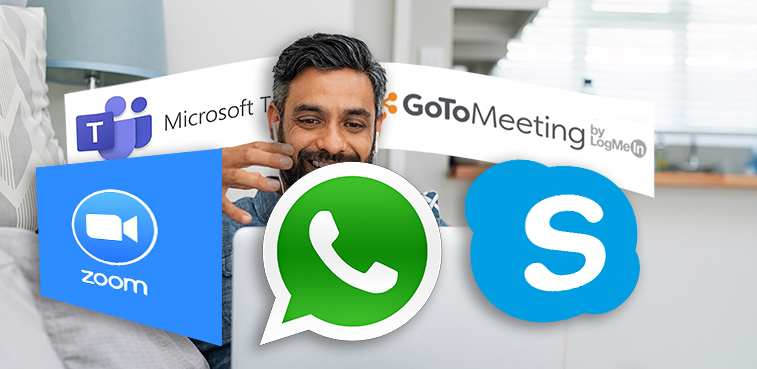With Coronavirus forcing offices to shut and making many people work from home, the increase in video calls is inevitable. There are many factors to consider when preparing for a video call, such as what to wear, lighting and background. However, to start with, you will have to decide which technology to use.

This is where our handy guide will help you make your choice. We have reviewed several technologies which are used for video calls in order to offer guidance. Enjoy our take on them and we hope you find what you need:
Zoom: Zoom provides a remote conferencing service that combines video conferencing, online meetings, chat, and mobile collaboration. It has a basic level of use, which is free and allows unlimited 1 to 1 conferences and has a 40-minute limit on group calls.
Pros:
- Easy to use
- High quality video
- Crisp audio
- Video conferencing is stable and reliable and supports long video calls
- Allows you to create a personal meeting ID and URL name which can easily be shared to the participants
Cons:
- It is heavy in the use of CPU resources
- Can slow down the computer and affect the overall performance of the device
Verdict: Comes highly recommended and the free plan offers amazing value. 5/5
Skype: A household name when it comes to video calls, Skype specialises in providing video chat and voice calls between a host of devices. In 2017, the estimated number of Skype users registered worldwide amounted to roughly 1.33 million.
Pros:
- There are screen sharing options available
- The paid subscriptions for Skype are cheap
Cons:
- Sound qualities on Skype are based on bandwidth
- Background noises are picked up rather easily
Verdict: While Skype is reliable and has been used successfully for many years, in terms of business calls it may not offer the best quality. 3/5

GoToMeeting: GoToMeeting is a web-hosted service created and marketed by LogMeIn. It offers a wide range of features such as screen sharing, video conferencing and being able to record meetings.
Pros:
- It allows users to have full control over the equipment of a participant
- You can share documents in real-time
- There are numerous integrations available
Cons:
- If your equipment is more than 5 years old, then you’ll need an upgrade before you can take advantage of the benefits offered by GoToMeeting.
- GoToMeeting does not offer an “always free” plan. The entry level plan, called “Starter,” is priced at $19 per month.
Verdict: Offers a high quality service, however this comes at a cost which some people may not want. 4/5
WhatsApp: With WhatsApp, you'll get fast, simple, secure messaging and calling for free, available on phones all over the world.
Pros:
- Works on both iOS and Android platforms
- The video quality is good even on a low-budget Android phone.
Cons:
- Only four people per video call
- There is a file size limit and you cannot send a file exceeding that limit
Verdict: An app which is more widely used for group chats rather than video calls but can still offer this feature if required. 2/5
During this period of lockdown, alternative ways of communication are going to be vital in order for your business to succeed. It is our firm belief that while you are not using your main office, and paying for everything that comes with it from lighting and heating to office milk, you should look to invest in one of the paid versions of Zoom or GoToMeeting. This will provide you with high quality channels of communication, allowing your business activity to continue as normally as possible.